As we first reported yesterday, the winning proposal to develop Transbay Block 6/7, from Folsom Street to Clementina Alley and Fremont to Beale, includes a 300-foot tower on the corner of Folsom and Fremont, 40-foot townhomes along Clementina, and three 50 to 85-foot mid-rise buildings on Fremont, Beal, and Folsom (click images to enlarge):
In total, 545 residential units (a mix of market-rate and subsidized), 10,000 square feet of ground floor retail and 136 underground parking spaces will be built on the site with multiple green roof gardens and decks above, parks and a mid-block paseo below.
Designed by Solomon Cordwell Buenz, the Block 6 Tower will attempt to leverage prevailing winds to ventilate and cool the building without air conditioning.
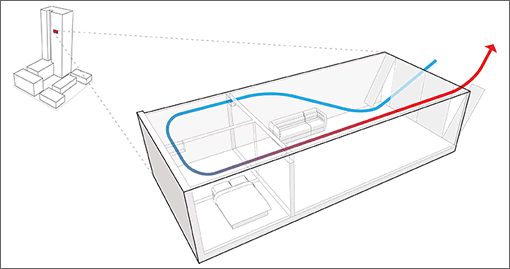
And as envisioned, a smart phone app will allow residents to remotely open and close their units’ blinds, regulating temperatures on the fly and from afar (click image to enlarge):
Up the tower, a series of sky gardens will grow.
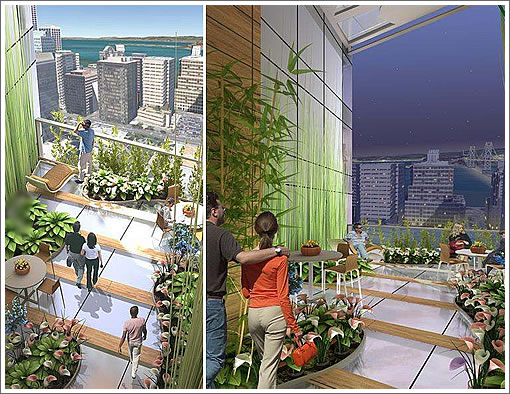
∙ The Winning Bid And Plan To Develop Folsom From Fremont To Beale [SocketSite]
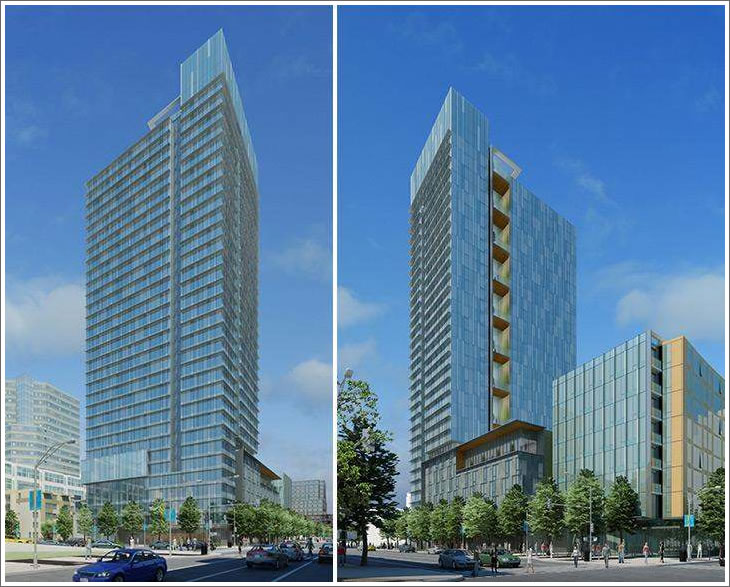
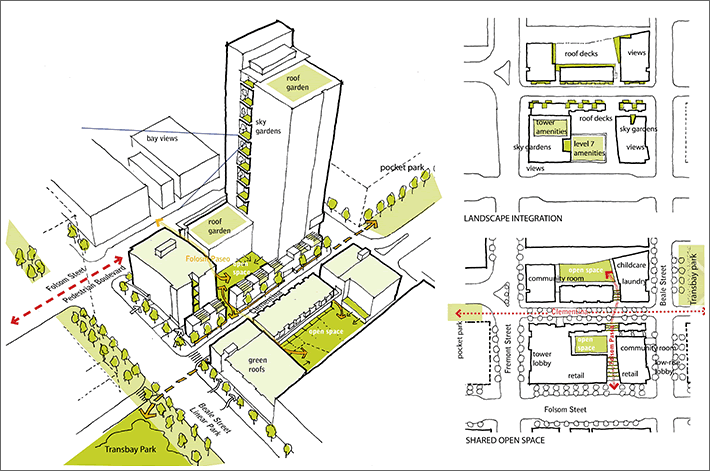
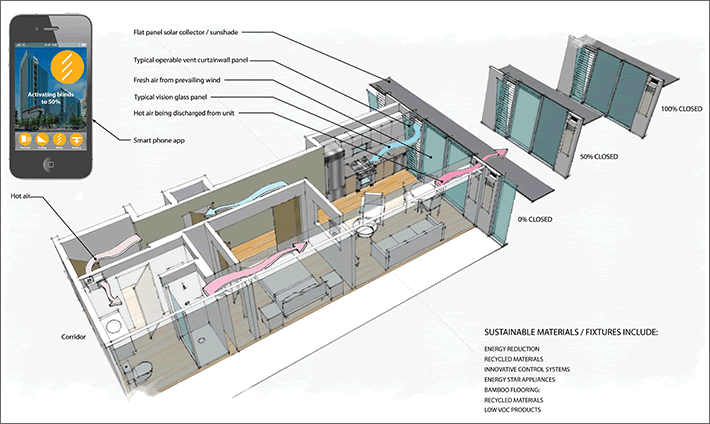
That’s an interesting passive cooling design. It took me a while to figure out how it works though. That must be a studio unit rendered there since there are no windows in the BR. I imagine that the effectiveness of the passive cooling will vary radically on opposite sides of the building.
I’m not a big fan of the facade aesthetics but do like everything else about this project.
I don’t see how the passive cooling is supposed to work with both cool and hot exiting from the same set of windows, and no cross ventilation.
The west facing apartments will be too warm all the time.
MOD, help me out.
Frankly I care a lot less about smart phone apps that control blinds than about getting this thing built out and improving the neighborhood.
It seems the cool wind air will enter the apartment through the bottom opening window. As the air enters the apartment it will warm and rise as a result. The rising warm air will circulate through the apartment and exit the top opening window. Pretty clever.
As Mike mentioned, the cool air will enter the unit through a window that opens inwards, gathers heat from the unit and then naturally rises out through the outward open window.
Clever indeed.
Jackson – The key is that the “in” window opens at the bottom and the “out” window opens at the top where the hot air will accumulate. Since hot air expands there is a tiny positive pressure gradient from the floor to the ceiling.
In addition the angle of the “in” window tends to funnel any wind into the interior, even slight gusts.
The induced airflow is probably very small but over time it can have a significant effect on temperature. It probably isn’t strong enough to battle an 85F day on a south facing unit though. You’d have to fall back on good old aircon for that.
This technique is similar to ancient middle eastern architecture styles that induce a tiny flow of cool air in, hot air out.
I am not so sure on the actual workings of this system neither. The rules of air density do say that you could generate an air flow between bottom and top, but as Jackson said it works much better when you have 2 opposite exposures.
Double exposure designs work 2 ways: air flow through pressure gradients and air temperature gradient. For instance the back of my place faces West. I can open all doors and windows at 4PM to push out the cool air from the East side. Free heating!
Also, the design of these windows allows warm air to escape from the top of the cold air inlet, and cool air to escape through the warm air outlet. This will diminish the overall efficiency of this system. Air always chooses the path of least resistance.
I cannot see how you can set this up for multiple rooms. The main room, I get it, with the caveat explained above, but the air flow in the bedroom could be really poor as designed. How can you have efficient circulation if both inlet and outlet are on the same level?
Talking about passive designs, natural light is a great disinfectant which makes a windowless bedroom a very very bad proposition.
I had a friend a long time ago who worked on a similar design for an NGO in Africa. The goal was to sun-dry tomatoes. Enough said.
I agree that cross ventilation is superior, lol. But here I think that the designer was working under the constraint of windows on only one side of the unit.
Has anyone lived in a building where on hot days the residents on both sides of the buildings open their windows as well as their doors to the hallway to create mutual cross ventilation? Works pretty good especially if you’re the only unit on your side with the hallway door open.
Sky gardens rather chilly on the north side, yes?
Those sky/roof gardens would be a great amenity to have. Not enough buildings have those.
The superiority of mutual cross ventilation makes be wonder why more buildings with operable exterior windows don’t also include a good old fashioned transom over the common hallway doors. It could even be a high tech remote iphone controlled transom if that’s what is required to capture people’s imaginations.
Is there some reason why transoms have gone out of style in modern buildings? Seems like a really simple solution. Do fire codes prohibit them?
So, $4.50psf rent and no A/C? Great.
I am aware hot air rises; however, if you look at the diagram as shown, the cold air enters at the top and the hot also exits at the top.
Without fans I see little chance of that air flowing through the bathroom and bedroom due to the aforementioned path of least resistance. Think dark and dank.
The whole design reminds me of a cruise ship cabin, and not anything where I would want to spend much time.
Transom over the common hallway doors?
What is this? a 1915 rooming house?
Fire safety codes would definitely NOT allow operable transoms between a unit and a public hallway.
Not to mention lack of noise control between units and hall, and odor control. And security.
MoD,
The design is what it is. I am especially concerned with the windowless bedroom as I said earlier. Even my walk-in closet has better air flow.
They’re building a glass box because this is what the market is today, but they want to minimize the costs (both building cost and theoretical cost of ownership). The way to sell the poor design it is through a token corrective design that will not work as well as they say it will. Ask the Beacon owners who are still in slow-cooking mode.
Good point about noise and smells futurist. I’d expect residents bothered by that to close their transom though.
Security is easy to fix by including a steel grate in the transom opening.
Fire safety is the most important factor. Many buildings include fire doors that automatically close when the fire alarm trips. I wonder whether the same concept can be used on transoms.
“Without fans I see little chance of that air flowing through the bathroom and bedroom due to the aforementioned path of least resistance.”
I completely agree, but based on the rendered floor plan it looks like fans will be used with duct work to channel the hot air, at least for west facing units.
“Block 6 Tower will attempt to leverage prevailing winds to ventilate and cool the building without air conditioning.”
And in late September and October?
Folsom Street to become a “pedestrian boulevard”? Huh?
Been quite comfortable in my low tech building without air conditioning for 30 years . . . and I even have windows in my bedroom. In fact, I have windows that face both east and west allowing “flow-through” ventilation which probably makes all the difference in the world. I’m not saying this won’t work, just that I wouldn’t want to be the market rate guinea pig for west and south facing units in this building. Seem like a design that simply makes the best of a bad situation.
Anyway, like some others above, I do want to see this project built to improve both Folsom St. and this part of town. That lot has been an eyesore for too long.
Science is so cool when you can just make it up as you go along!!!
I am at the Infinity and have both westward and eastward facing windows in the midrise/tree-top building and can definitely vouch on the heating effect on a sunny afternoon (even w/sunshades down). Perhaps because I’m on a lower floor (view more of the courtyard than anything else) that even opening up the windows on both sides doesn’t do much to vent although opening up the door to the hallway does a little bit.
Re: Pedestrian Boulevard
I remember before and after purchasing allusions to future plans to close off auto traffic and convert Folsom street into a pedestrian only boulevard (ala Las Ramblas) from the Embarcadero westward for a few blocks. This is the first time that I’ve seen a reference to it in awhile. Any updates to confirm or to the contrary?
My apartment has a system like that. It doesn’t work.
I live on Folsom and all my windows face south.
Without “cross ventilation” there is no cooling.
The design of the building is a disappointment. Another boring glass box. It seems all the cool architecture these days is in NYC, Chicago or overseas.
“Pedestrian boulevard” doesn’t mean a boulevard closed to traffic with only pedestrians walking on it. It refers to the plan to make Folsom a pedestrian-friendly street – two-way vehicle traffic (vs. partially one-way/confusing now) between Essex and Embarcadero, tree-lined, local retail, with wide sidewalks for lots of pedestrian activity. It was never intended to be closed to car traffic.
The same architects are doing the conversion of the AAA tower. For those deep floor plates they devised a similar ventilation solution – a contortion of the codes – so they could call these rooms “Bedrooms”. DBI went along given the situation and the tall office bldg ceilings in that project.
But now it’s a precedent, and (my theory) the developer wants to reap the advantages of this “innovation” with deeper floor plates, less skin, and more units, while still meeting the Eastern Neighborhoods unit mix requirements.
Don’t know if potential buyers/renters will go for it. But worth a try.
Milkshake – hallways are required to be fire rated in most buildings (there are exceptions, but rare) Operable transoms could be installed and tied to the fire alarm system, but they get expensive really quick.
As a segway, the operable systems they’re proposing for the passive cooling will be really expensive as well. And will probably not be built in the end.
I feel that building a 400ft tower will be good since the tower will be blocked by 75 Howard. 75 Howard will rise 350 ft so it seems that 400ft would be more appropriate. However, I really like the design, I enjoy the rooftop gardens, it would be cool if they built a roof top pool 🙂
and whats up with 50 first street and 1st and Mission??
I am doubtful of the above design’s success…
The challenges of mixing architecture with reasonable weather accomodation:
http://www.nytimes.com/2012/08/05/us/where-indoors-can-become-too-much-like-outdoors.html?_r=0
Really!? 136 parking spots for 545 units? come on, what is with the planning dept. of SF and it’s constant denial that some people drive because of work and guess what, Muni sucks!
Re: the design of the building, not surprised it’s the same architects redoing the AAA tower on Van Ness, looks just like it.
UPDATE: Green Development Breaks Ground For Tower And Retail On Folsom.